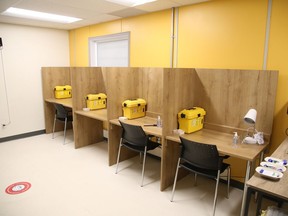
Launching a drug treatment court, continuing efforts to open a consumption and treatment services site, and better supporting Indigenous people using drugs are among the goals in the 2024 Brantford-Brant Drugs Strategy Action Plan.
Advertisement 2
Article content
The Brantford-Brant Community Drugs Strategy is a community initiative made up of a partnership including public health agencies and municipal organizations. Members include, among others, the Brant County Health Unit, St. Leonard’s Community Services, Brantford Police Services, the City of Brantford and County of Brant, and Brantford Substance Users Network.
Article content
“The Brantford-Brant Community Drugs Strategy remains committed to carrying out the immediate actions within the 2024 action plan,” said Alyssa Stryker, drugs strategy coordinator with the health unit. “We are dedicated to regularly communicating our progress to the community, ensuring that our efforts are not only impactful but also well understood and supported by those we serve.”
Advertisement 3
Article content
The rate of opioid-related fatalities in Brantford-Brant remained similar in 2023 compared to 2022 and continues to be about 1.5 times the provincial average. Brant’s rate of emergency department visits for opioid overdose remained twice the provincial average in 2023.
“The factors driving the overdose crisis are complex,” said the report. “There is no single cause, although the unpredictability and contamination of the illicit drug supply is recognized as a major driver.”
The Brantford-Brant Drugs Strategy Action Plan includes 18 goals for this year. Among them are:
- Explore and implement a universal screening for substance use disorder.
- Scale up the availability of the PreVenture program, which aims to promote mental health and delay substance use among youth.
- Launch a drug treatment court, which allows people charged with certain low-level drug-related crimes to complete a drug treatment program in lieu of incarceration.
- Reduce stigma against people who use drugs through sector-specific anti-stigma education.
- Open a consumption and treatment services site in Brantford. These are places where people can use pre-obtained drugs indoors in a safe, clean facility and overdoses can be reversed by professional healthcare providers.
- Build relationships between the drugs strategy and local Indigenous-led organizations to help improve the quality of services for Indigenous people who use drugs.
- Access support needs of businesses and service providers in downtown Brantford to reduce the harms of drug use in their establishments.
- Scale-up Brantford-Brant’s safer supply project, which involves providing prescribed medications as a safer alternative to the illegal drug supply to people who are at high risk of overdose.
- Expand access to drug checking services. This would build on a 2023 pilot project to distribute fentanyl test strips so people who use drugs can detect whether fentanyl is present in the drugs they intend to take. Plans call for the implementation of a similar pilot program for xylazine, a non-opioid tranquilizer that has been found in the illicit opioid supply.
- Expand support for families of people who use drugs.
- Launch a peer support “community of practice.”
- Expand awareness and access to naloxone among seniors. The drugs strategy “is concerned that seniors are falling through the cracks when it comes to substance use-related services and education.”
- Expand access to harm reduction supplies in the County of Brant. The report says Brant residents “still have limited options” to access supplies.
- Develop a formal process for ensuring future action plans are developed with input from people with lived experience of drug use.
The strategy also calls for expanded access for pregnant women to “non-stigmatizing and supportive perinatal healthcare,” and addressing challenges for people who use drugs and have specialized needs, including those involved in sex work, pregnant women, and LGBTQ2S people.
Article content